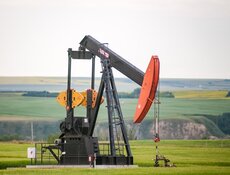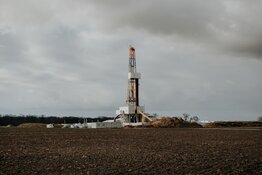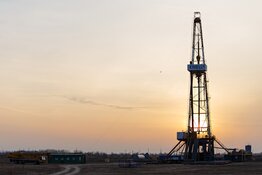Amir Arif: That is one way to do it. I do think the margin in the drilling activity should be improving, and the level of activity will be higher than what the commodity prices would suggest. But the better way to invest in the space, in my view, is to find the companies that are in these low-cost basins so that you know they have a good margin, regardless of whether gas is forecast at $4, $5, or $6. The bigger question is: does the space have volume growth behind it? Don't make a bet on the commodity, which is what we're seeing.
Gas doesn't have positive drivers behind it. You want to make a bet on the volume without diluting the equity. And that's something that was difficult to do in the past; I mean I've covered the space for over 10 years and worked as a petroleum engineer before that. You just could never grow your volumes in the double digits without having to issue equity, unless you got lucky and had great exploration success.
TER: What's allowing that to happen now?
AA: It's these shale plays! Technology unlocked them, and they're coming in right at the low end of the cost curve. It's changing the entire dynamics of the gas market. Marginal supplies still need $5–$6 gas. But if you're in the Marcellus Shale, where it's only $3 to break even, that's all you need; your excess cash flow is dramatic. And in this space, you've never had free cash flow.
TER: In another report you said, "On average, undeveloped acreage expiring as a percentage of total undeveloped acres held will increase from 11% in 2009 to 16% in 2010 and 20% in 2011." Why is this a problem? And does it create opportunities for companies to acquire leases?
AA: Well, it's a problem because people are going to produce more gas than what the economics are telling us to produce. And that's what we're already seeing as rig counts continue to move up, even when gas in January went from $6 all the way to March when it dropped to $5. So, basically, people are drilling more than what the gas price is signaling, in terms of demand. That's why it's a problem; it's causing a bubble in gas supply.
But it's a short-term problem, a problem through mid-2011. Does it create an opportunity for companies? It's creating an opportunity for a lot of the international integrateds that have deep pockets. They would like to move into these shale plays, because, again, a lot of this acreage needs to get drilled. They can bring the capital to make sure it gets drilled before it expires.
TER: Have you seen that happening?
AA: Yes, we've seen Total S.A. (NYSE:TOT); we've seen a handful of integrateds already in the U.S.—Chesapeake Chesapeake Energy Corp. (NYSE:CHK), Statoil ASA (NYSE:STO; OSE:STL), Mitsui & Co. Ltd. (NASDAQ:MITSY)—a lot of them.
TER: Have some of those companies become better investment opportunities than they were before this happened?
AA: It changes the outlook for companies holding the acreage because you've got a greater comfort level that they will be able to hold on to that acreage, and you've got more visible funding. So you're able to be a little more comfortable with growth projections going forward for that company. But, again, the growth for one company isn't necessarily great for the industry as a whole.
TER: What is Stifel & Nicholas projecting for the gas price to the end of this year and to the end of 2011?
AA: As an average, we're looking for $5.20 gas in 2010, moving up to $5.75 next year and then long term, $6 flat by 2012.
TER: But even though the gas price isn't going up much in the short term, you're seeing companies refusing to reduce capital expenditures, and instead they're allocating capital to higher-return projects. A couple of examples are projects the Marcellus and Eagle-Ford plays. What are some companies with heavy exposure to those?
AA: That's a good point. You haven't see them cut back drilling and you mentioned a couple of areas where they're putting capital, but it's not just because those plays are good, it's also because that's where the some of the acreage-expiring issues are—the Haynesville's another one. One of our favorite names with exposure there is Atlas Energy Inc. (NASDAQ:ATLS). Another favorite is Cabot Oil & Gas Corp. (NYSE:COG). Other companies with a lot of exposure out there would be Range Resources Corporation (NYSE:RRC), Ultra Petroleum Corp. (NYSE:UPL) and Rex Energy Corp. (NASDAQ:REXX).
TER: Let's start with Atlas.
AA: Atlas is our favorite idea in the Marcellus because they recently did one of these joint-venture deals with Reliance Industries Ltd., an Indian company, for $1.7 billion. It was a high marker in terms of what people were receiving in dollars per acre. We know they're sitting on some sweet acreage. We now know they have good funding available, meaning no equity dilution needed to get the growth going. And it's also a company where we see a huge discount between the stock price and what we think the underlying value of the company is. That's why that's our favorite.
The other one is Cabot, and the reason we like that one is more because of where they are; they're in the northeast Marcellus.
TER: Northeastern Pennsylvania (NEPA)?
AA: The NEPA, that's right, and that's where the play gets bigger; the Marcellus actually breaks into two different zones. You have the potential to have twice as many locations in the NEPA versus someone in the southeast part of the Marcellus or the southwest part of the Marcellus. They are just sitting on a great location; they've already got the production going, increasing by 15%–20% a year, and we see that production staying in the 15%–20% a year range for the next five years, all funded with cash flow.
TER: And Range?
AA: Range is probably the darling in the marketplace right now for the Marcellus exposure, but that's the reason it's "market perform - neutral" for us; it's just the valuation. Range definitely was the first one in the play; they have one of the best track records in the play. It's just the valuation that keeps it on the sidelines for us. Atlas and Cabot, in our view, are more attractive when you look at the stock price and the assets.
TER: Ultra?
AA: Ultra Petroleum. That firm was successful in Pinedale production in the Rockies. They moved into the Marcellus about three years ago and they're getting some terrific results. So you've got the Pinedale giving you a solid base growing in the single digits, and then you layer on top of that the Marcellus, and all of a sudden you've got a company with some pretty solid growth, and again two very low-cost operations—the Pinedale and the Marcellus.
TER: A May research report from your firm concluded that "producers with materially lower hedged volumes in 2011 vs. 2010 should relatively underperform and unhedged names with clean balance sheets should relatively outperform." What are some of your favorite unhedged names with clean balance sheets?
AA: The two names that we really like from that angle would be Southwestern Energy Co. (NYSE:SWN) and Comstock Resources Inc. (NYSE:CRK). If you go back over the past four to six months, the companies that were more unhedged when gas started rolling down were punished the most; so Southwestern and Comstock both materially underperformed the rest of the index in the past six months.
But at this point, when you start looking from 2010 to 2011, whether you're hedged or unhedged you don't have that great of a price advantage, whereas in 2009 it was a very big difference. If you were unhedged, you were getting $4–$5 for your gas, while other companies had great hedges of $7–$8. That's a big difference in the cash flow you would receive. But when you go to 2011, even the companies that are hedged, they're only hedged in the $5–$6 range, and if you look at where the futures are, it's in the $5–$6 range as well. The unhedged names have already relatively underperformed; the disadvantage of being unhedged isn't such a big disadvantage as you move over to 2011. We think the relative underperformance will catch up for those two names.
TER: Some investors are looking for opportunities in the small cap space. What are some companies that you're following there?
AA: Comstock is definitely a name we like in the small cap space; it's a Haynesville producer, again relatively unhedged, a quality management team. They don't have to drill just to drill, and they have a good valuation, and a good asset base.
The other name that we like that we upgraded recently is Bill Barrett Corporation (NYSE:BBG). That's a small cap name that we think has been overlooked by the marketplace, primarily because it's a Rockies producer; it doesn't have a sexy shale play to talk to the Street about. It's a conventional company, and the biggest issue for them has been—they've always been cheap on an valuation basis—they've been waiting on an environmental impact approval at the federal level before they can start drilling their key asset. We believe that should come in by August or September, and when that comes in this company will start to grow production dramatically in 2011 and 2012.
TER: I was reading several of your research reports and BBG kept coming up in a number of favorable categories in your charts. But you weren't trumpeting that stock at that point. I think that might have been in May.
AA: That's right; at that time and over the past 12 months, to us it was more of a valuation trap. It looked very cheap, but there was nothing in place to change the valuation. To us it was just a value name that would stay as a value name. But once the environmental impact final approval comes in, which it is expected in August/September, production should finally start growing dramatically. And that's what changed our outlook.
TER: How much of a factor are the natural gas liquids now? If someone has significant assets with a lot of liquids in play are they getting value for that in their share price?
AA: Companies are starting to push that angle and you see companies trying to increase their liquid weighting. I think they realize there is plenty of gas, so the only thing that's really going to change the price long term is new sources of demand. And the economics get better when you add liquids to the mix.
But from our perspective, people have already bought into the liquids-rich gas plays and the risk is that NGL (natural gas liquids) pricing will come down. If you look at the NGL stream, most of the value comes from ethane, and if you look at ethane, it's more of a localized market, certainly not an international market like crude oil. In the U.S., the key drivers are really autos and construction. Until you see significant pick up in energy demand, everyone chasing these liquid plays is going to cause too much NGL production, which is going to bring the NGL pricing down for next six months.
TER: For the next six months?
AA: Yes, so the economics will still be better relative to dry gas, but they're not going to be as good as they look today. But I just want to point out one thing. We do actually think the gas price could surprise to the upside over the next month or two. It's just because there is such a huge short position on gas because everyone knows there's too much supply out there, but what you also have is increased forecasts calling for hot summers and high hurricane activities. I wouldn't be surprised if gas actually has more upside than downside over the next couple of months. When storage gets full, gas will definitely have to come back down for the cash prices. But short-term gas could still surprise to the upside.
TER: Are there any companies poised to take advantage of short-term gas prices?
AA: I think those are the unhedged names, Southwestern and Comstock. People have changed their outlook on those a little more, at least for the cash flow that they're thinking they can deliver.
TER: What are some companies that have their costs in check, strong balance sheets and are always boosting their efficiency as a means of becoming more profitable in this gas price environment?
AA: It's something you've seen in all the plays as people move up the learning curve. You either get more efficiencies or you'll go back to doing what you were doing. But the more recent improvements have been in the Haynesville and the Marcellus, and we will see it in the Eagle-Ford over the next 12 months. Right now, people are still doing a lot of testing in the Eagle-Ford wells; more logs, more coring, to get a better sense of what they have, but the well costs are sitting closer to the $6–$7 million range, but as they start approaching more of a manufacturing approach, those costs should go closer to $5 million.
TER: What is the average cost of a well?
AA: In the Eagle-Ford today it's probably close to $6–$7 million, but it's going to get to $5 million. In the Marcellus, it's $3–$3.5 million. The Haynesville is where you need deeper pockets; those well costs were $12 million in mid-2008; they dropped to $8-9 million in the third quarter of 2009, which was the bottom. Now they've moved back to the $10–$10.5 million range.
TER: What about some oily names out there?
AA: A lot of the oily names have already dramatically outperformed, just because oil fundamentally has held up a lot better than gas with a tighter supply situation. The one name that we don't think has outperformed as much and still has plenty of upside would be Pioneer Natural Resources Co. (NYSE:PXD). It's one of our three favorite names; they're 50-50 in terms of the gas/oil mix, but about 75% of their capital is geared toward oil, and it's all in the Permian, an older basin. The Spraberry Field has been in production for over 40 years, probably will go for another 40 years. It's very low risk, just great cash flow margins, given the oil price.
TER: You said it was one of your three favorite names. What are the other two?
AA: If you want a low-risk name, Bill Barrett Group is our favorite just because it's got a very cheap value to it and that should support the stock price where it's at. If you want to take a little more risk, PXD is the next name worth going to. And, again, it's the high free cash flows you get from their Spraberry field, plus the Eagle-Ford upside, and they're in the process of doing a joint venture in the Eagle-Ford. That should get announced soon, and that should allow them to start accelerating their Eagle-Ford development plans. If you're willing to take higher risks, then Atlas is a name worth looking at, but over there I would say have at least a 12-18 month timeframe to invest in that.
TER: Any final thoughts on the oil and gas market?
AA: Oil has better supply/demand fundamentals on the macro side. So if investors are looking at oil, they want to be looking at the high free cash flows, and that is what oil gives you. But if you're looking at gas, focus on the names with low-cost production sources, and the names that can grow volumes without diluting equity. If you do that, you'll have a winning combination on both sides.
Amir Arif joined the Stifel Nicolaus research team in April 2009. He has more than 15 years of experience in petroleum engineering, investment banking, and investment research of the energy sector with a focus on upstream oil and gas companies in the U.S. and Canada. Mr. Arif received his BSc in petroleum engineering with distinction from the University of Alberta and his MBA in finance from the University of Calgary. He also holds the CFA and CMT designations.
Want to read more exclusive Energy Report interviews like this? Sign up for our free e-newsletter, and you'll learn when new articles have been published. To see a list of recent interviews with industry analysts and commentators, visit our Expert Insights page.
DISCLOSURE:
1)Brian Sylvester of The Energy Report conducted this interview. He personally and/or his family own the following companies mentioned in this interview: None.
2) The following companies mentioned in the interview are sponsors of The Energy Report: Atlas Energy.
3) Amir Arif: Stocks mentioned: RRC, SD, SU, SWN, UPL, CRK, XCO, XTO, ATLS, BBG, CNQ, COG, CHK, CLR, EQT, HK, NFX, FST, GMXR, PXD, ROSE, PQ, PVA. View disclosure.







































